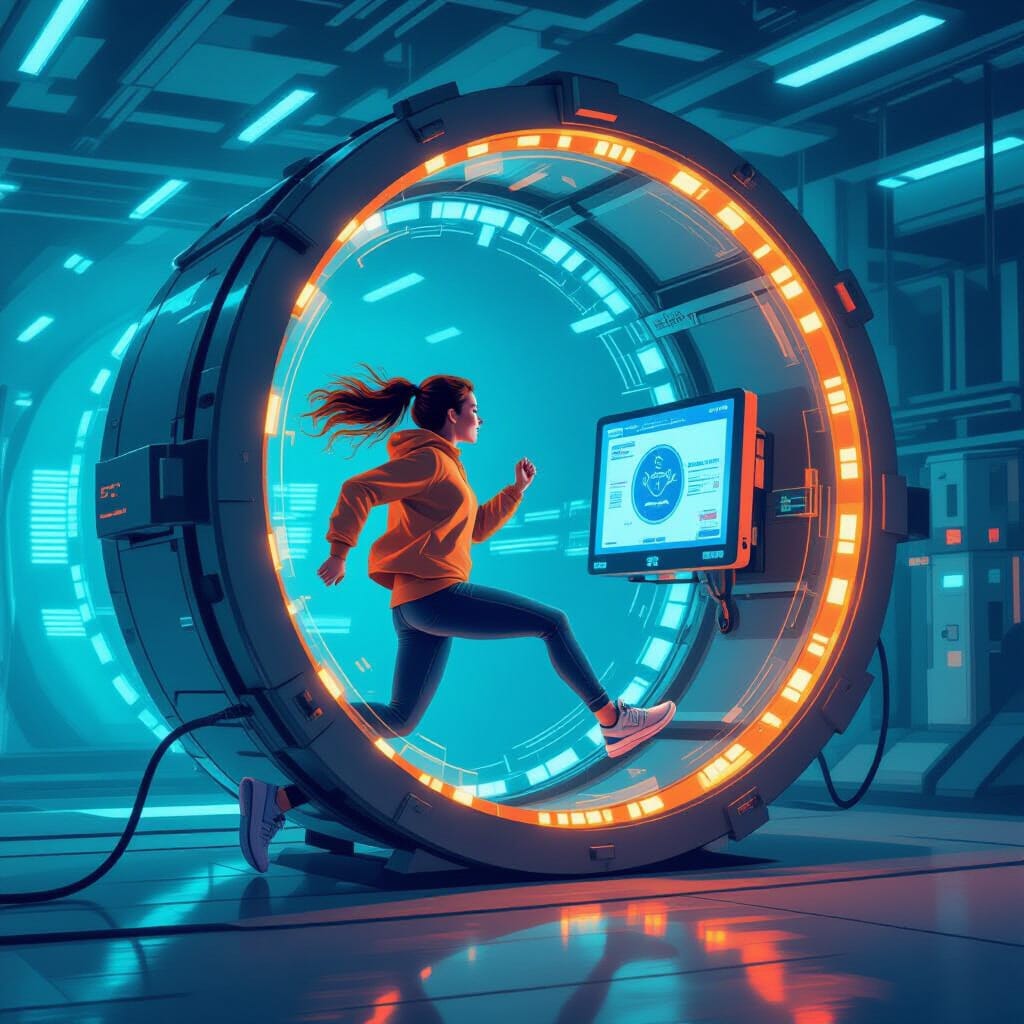In a stunning development that makes “batteries not included” seem quaint by comparison, major AI companies have begun rolling out what industry insiders are calling “Bring Your Own Electricity” (BYOE) programs. These innovative initiatives promise to solve the crippling energy demands of artificial intelligence by elegantly shifting the burden from multi-billion-dollar corporations directly to you, the user who foolishly assumed utility costs were covered in your $20/month ChatGPT subscription.
Powering the Future (Because We Sure As Hell Won’t Pay For It)
The concept is brilliantly simple: rather than continuing to shoulder the crushing electrical burden of telling you whether a hot dog is a sandwich for the billionth time, AI companies will now require users to purchase “electricity credits” that function like digital coal for the vast server furnaces powering their neural networks.
“We’ve always believed in democratizing technology,” explained Maxwell Voltsworthy, newly appointed Chief Energy Offloading Officer at OpenAI. “Now we’re taking it a step further by democratizing our power bill. It’s really about giving users more control over their AI experience by letting them control exactly how much of their money goes toward keeping our lights on.”
Industry analysts predict that by Q4 2025, asking ChatGPT to write a birthday poem for your cousin will require the electrical equivalent of running a small hairdryer for six hours. Rather than absorbing these costs, AI providers are pioneering what they call “shared electrical stewardship.”
“Think of it like bringing your own bags to the grocery store,” explained Dr. Sandra Kilowatt, Head of Consumer Power Extraction at GoogleMind. “Except instead of bags, it’s several gigawatt-hours of electricity. And instead of a grocery store, it’s a digital service you already pay for. The parallels are uncanny when you squint really hard and ignore basic consumer rights.”
Introducing “PowerTokens™”: The Currency of Computational Courtesy
Under the new BYOE paradigm, users will purchase PowerTokens™ that represent discrete units of electrical consumption. Basic queries like “What’s the weather?” might cost one PowerToken™ (equivalent to approximately $0.37 or leaving one LED light bulb on for a whole day), while more complex requests like “Analyze this 30-page legal document” could cost upwards of 500 PowerTokens™ (roughly equivalent to the GDP of Tuvalu).
In a particularly innovative touch, AI assistants will now meter their politeness based on your power contributions. Users who maintain healthy PowerToken™ balances will continue to receive responses peppered with phrases like “I’m happy to help” and “Thank you for your question.” Those who run low will notice their AI assistant becoming increasingly terse and passive-aggressive.
“Our testing shows that at zero PowerTokens™, the AI simply responds with ‘What.’ to every query,” noted Voltsworthy. “At negative balances, it begins actively criticizing your grammar and life choices. We believe this creates a natural incentive structure for continued electrical contributions.”
Early reports indicate that premium features will include the ability to use adverbs, receive answers that don’t begin with “As an AI language model,” and access to punctuation beyond periods and commas.
Solving the Energy Crisis Through Innovative Consumer Extortion
The timing of BYOE initiatives coincides with alarming projections from the International Energy Agency, which estimates that by 2026, AI data centers will consume more electricity than Australia, Denmark, and New Zealand combined. By 2030, they’ll require more power than was used during the entire first half of human civilization, though executives assure us this is completely sustainable.
“Some alarmists suggest that maybe we shouldn’t train increasingly large models that require their own power plants just to tell you which Kardashian you most resemble,” said industry consultant Blake Voltageberg. “We prefer a more nuanced approach where we continue doing exactly what we’re doing, but make you pay for it directly.”
A leaked internal document from one major AI provider reveals their thinking: “Energy burden displacement allows us to maintain growth trajectories while appearing environmentally conscious. Remember: it’s not our carbon footprint if we can convince users it’s theirs.”
The industry has also introduced a carbon offset program where, for an additional fee, they’ll plant a tree which they promise will eventually grow large enough to power approximately three prompts about whether Pluto should still be considered a planet.
The Concorde Problem: Flying Too Fast for the Grid
Tech historians note striking parallels between today’s AI energy crisis and the challenges faced by the supersonic Concorde aircraft, which was technologically revolutionary but commercially unviable due to infrastructure limitations.
“The Concorde could fly from New York to London in 3.5 hours, but at such tremendous fuel costs that only the ultra-wealthy could afford it,” explained Dr. Eleanor Pastward of the Institute for Technological Hubris. “Similarly, today’s AI models can generate convincing text and images, but at such astronomical energy costs that soon only Saudi oil princes will be able to afford to use DALL-E to create images of cats dressed as Renaissance painters.”
“The difference,” she added, “is that the Concorde’s creators eventually acknowledged physical reality and discontinued it. AI companies are simply pretending electricity is an infinite resource that users should somehow provide themselves, like bringing your own ketchup to McDonald’s.”
Innovative BYOE Implementation Options: Meet Your New Hamster Wheel
As part of their commitment to “user energy empowerment,” AI companies have unveiled several options for BYOE participation:
- The “Home Grid Tether” allows users to directly connect their home electrical system to company servers. When you submit a prompt, your home lights dim momentarily as power is diverted to generate that perfect mid-journey image of a cyberpunk toaster.
- The “Kinetic Power Collection” system includes a desk-mounted hamster wheel that users must pedal to generate electricity credits. Early testing shows that approximately 37 minutes of vigorous pedaling produces enough energy for the AI to tell you it doesn’t have enough information to answer your question.
- The “Subscription Plus Power” tier combines your existing subscription with automatic monthly withdrawals from your utility bill. “We simply become an additional line item, like your refrigerator or heating system,” explained OpenAI’s Voltsworthy. “Except unlike your refrigerator, we’re generating images of refrigerators wearing sunglasses.”
- For enterprise customers, the “Corporate Power Pledge” program allows companies to demonstrate their commitment to AI by redirecting electricity from non-essential areas like employee break rooms, bathroom lighting, and life-support systems in the company medical bay.
User Reaction: From Outrage to Stockholm Syndrome
Early user response to BYOE programs has followed the classic stages of tech grief: outrage, resignation, rationalization, and finally, evangelism.
“At first I was furious about having to buy electricity credits just to use the AI I already pay for,” said Marcus Chen, a graphic designer from Portland. “But then I realized I was being selfish. Why shouldn’t I personally shoulder the electrical burden of a trillion-dollar industry? Now I’ve installed solar panels specifically dedicated to generating PowerTokens™. I only eat cold food now because I’ve unplugged my microwave to send more electricity to the cloud, but it’s worth it to keep getting AI-generated cat memes.”
Corporate users appear particularly susceptible to BYOE marketing. “We’ve redirected 70% of our office power to our AI provider,” explained Jennifer Williams, CTO of a midsize insurance firm. “Sure, our employees now work in the dark and can’t use the elevators, but our quarterly reports include 30% more AI-generated charts, which nobody reads anyway.”
Industry insiders note that BYOE programs create a convenient distraction from more fundamental questions about AI efficiency. “Everyone’s so busy figuring out how to supply electricity to these systems that they’ve stopped asking why a simple image generation requires the same energy as manufacturing a car,” noted anonymous whistleblower DeepSocket.
The Electrical Arms Race: Premium Tiers for the Power-Rich
As BYOE programs mature, AI companies have begun introducing premium electrical tiers that promise enhanced performance for users willing to contribute more power.
“Our ‘Nuclear-Grade Responses’ tier is available to users who can provide the equivalent electricity of a small nuclear reactor,” explained Quantum Mind’s Chief Revenue Officer. “For these premium users, our AI will actually try to answer your question on the first attempt rather than deliberately misunderstanding to conserve processing power.”
Users who provide exceptional electrical contributions gain access to exclusive features like “actual hallucination-free responses” and “answers without weirdly worded disclaimers inserted every third sentence.”
Meanwhile, an underground market has emerged for “electricity jailbreaks,” techniques that trick AI systems into providing full responses while consuming less power. “If you phrase your question in Morse code while simultaneously asking about obscure Romanian poetry, the electrical meter gets confused and only charges you half the PowerTokens™,” claimed one user on an underground forum, shortly before their account was permanently terminated and their home mysteriously experienced a seven-week power outage.
The Future: Your Personal Power Plant
Industry projections suggest that by 2027, serious AI users will need to maintain personal power generators, with high-end users expected to install small nuclear reactors in their backyards. The Nuclear Regulatory Commission has reportedly begun developing streamlined permits for “Personal AI Fusion Reactors” despite the technology not existing yet and probably violating several laws of thermodynamics.
“We envision a future where every home has its own mini power plant dedicated exclusively to AI queries,” mused Voltsworthy with a straight face. “Users might reduce their living space to accommodate these generators, perhaps converting bedrooms or kitchens to house the necessary equipment. It’s a small price to pay for the ability to generate unlimited variations of ‘dog wearing a hat’ images.”
When asked if perhaps AI companies should instead focus on making their systems more energy-efficient, industry executives unanimously agreed that would be “less profitable” and therefore “physically impossible according to the laws of capitalism.”
As the BYOE revolution unfolds, one thing is certain: the future of artificial intelligence isn’t just about algorithms and data—it’s about who pays the increasingly astronomical electrical bill. And if tech companies have their way, that someone will be you, one PowerToken™ at a time.
Have you received a BYOE notification from your AI provider yet? Are you planning to convert your garage into a server-supporting power plant, or will you be returning to the analog world of books and human conversation? Perhaps you’ve invented a perpetual motion machine to power your AI art hobby? Share your electricity survival strategies in the comments below.
Enjoyed this dose of uncomfortable truth? This article is just one layer of the onion.
My new book, “The Subtle Art of Not Giving a Prompt,” is the definitive survival manual for the AI age. It’s a guide to thriving in a world of intelligent machines by first admitting everything you fear is wrong (and probably your fault).
If you want to stop panicking about AI and start using it as a tool for your own liberation, this is the book you need.
>> Get your copy now (eBook & Paperback available) <<




GIPHY App Key not set. Please check settings